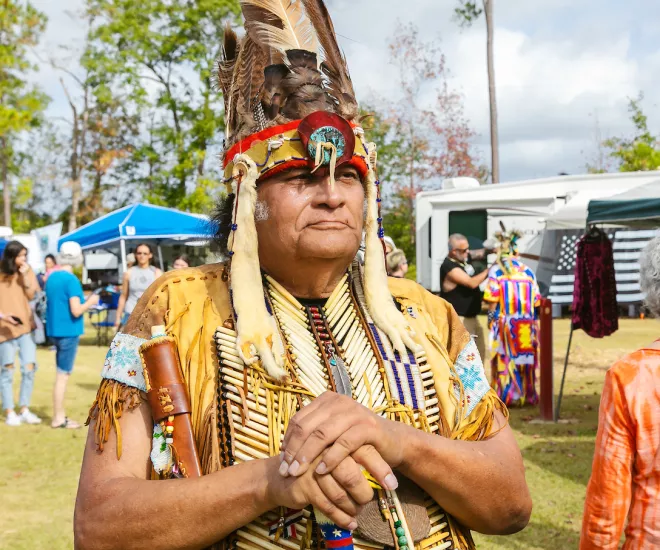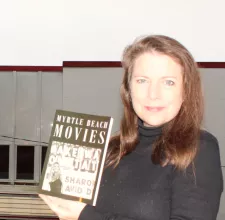The Waccamaw: Indigenous People of the Myrtle Beach Area

A History of Resilience and Culture
In the late 1980s, an archeological survey of what was then the Myrtle Beach Air Force Base, now The Market Common District, revealed evidence of Early to Middle Woodland prehistoric campsites dating back 3000 years. We don’t know what happened to the inhabitants or who they were.
From the clues that were left behind, anthropologists put together that they were probably nomadic, following their seasonal food sources. They traveled by foot and possibly canoe. Indications were that these first indigenous people ate seafood, wild game, edible plants from the woods and may have grown vegetables. They made pottery and tools for hunting and dressing game. Only fragments of these things and piles of oyster shells have been discovered in the Myrtle Beach area since.
Within a century of European settlers arriving on our coast from approximately the year 1670, the later indigenous people, The Waccamaw, were no longer here. More accurately, some were still here, but public records didn’t necessarily reflect that.
Those who can trace their ancestry back to these people are now part of one of nine Native American tribes recognized by the State of South Carolina. The Catawba are the only ones in the state to be federally recognized. The Waccamaw now own property near Myrtle Beach which serves as the headquarters for their tribal council.
In time, the tribal land may house offices, ceremonial grounds, an activity and meeting center, a reconstructed tribal village, a museum and a trading post. Also at that location they periodically hold a pauwau, a traditional celebration involving music and food, to which the public is invited. To find out what is currently available and when the next public events are going to be held, please go to their website.
Presumably, those here several millennia before the Waccamaw were their ancestors. The Woodland Period with which they are associated is described by anthropologists as occurring between 500 BC and AD 1100. Their homes, clothing, tools and food were similar to those of their predecessors, but this new era was indicative of innovations apparent in that discovery of the 1980s.
The cultivation of crops added a new food source to the practice of gathering whatever happened to be growing. It also encouraged a lifestyle that was more settled and less nomadic. Hunting was taken to the next level with the bow and arrow which allowed for more precision over the traditional spear throwing. A functional art manifested in the making of pottery. And on a larger scale, the creation of mounds became prevalent.
Earlier in the last century, partially excavated shell mounds on Waites Island near the North Carolina border were unearthed. Within the mounds, a harpoon point, a pottery smoothing tool, evidence of fireplaces and post-holes, animal bones, and shells from oysters, clams, periwinkles and sea snails were discovered. Heaps of oyster shells left by Native Americans have been found in several places in the Myrtle Beach area.
Hurricanes have revealed some of the region’s more interesting artifacts from that era. A canoe was excavated at Ocean Lakes Campground in the wake of Hugo in September of 1989. More than a century before, a great storm uncovered a Native American pot along what is now Surfside Beach near what was then the Ark Plantation. The account was given by a former enslaved African man who had lived on the Ark Plantation at that time. He told the story in an interview that was recorded in the 1930s.
Words from our area’s earliest languages are still used today. The Wampee Community near Conway gets its name from a plant, also called wampee root, eaten by wild game birds. It is thought to be another name for the pickerel weed also known as Pontederia which was prevalent in this area centuries ago.
Wacca Wache Marina on the river in Murrells Inlet explains on their website that their name is a combination of Waccamaw which means “happy waters” and Wachesaw, the name of the community adjacent to them, that means “happy hunting.” Socastee, just up the river from there, was named for the creek that was known during the Colonial Period as Sawkastee. Its definition is unknown.
Chicora is defined as meaning “the land.” Different tribes used the word for that purpose, but one became known for it. Europeans began calling the people, Chicora, who more accurately refer to themselves today as Chicoran Shakori Oyate. They explain that “Chicoran refers to the area. Shakori is the name for the people, and Oyate is a word for nation or tribe.”
Major rivers and bays in this region of the state take their names directly from indigenous people, the Waccamaw, the Pee Dee and the Winyah. This is appropriate as those bodies of water served as their major highways. However, one of Myrtle Beach’s most significant thoroughfares, Kings Highway, began as an indigenous trail before the settlers arrived who gave it its European-influenced name.
It is Europeans who are believed to be behind the apparent disappearance of the Waccamaw and other groups from recorded history around the mid-1700s. The first written mention of the Waccamaw River circa 1732 corresponds to about the time when the people for whom it was named stop being mentioned.
What was recorded was the occurrence of warfare between the Waccamaw and settlers who had begun encroaching on their tribal territory. It is said that even more Native Americans died from the new diseases that the Europeans unwittingly brought with them from abroad than those who were killed in combat. For the ones who survived, enslavement was sometimes their fate. They would work side by side with Africans who had been brought to the area for the purpose of forced labor on plantations.
In 1752, a royal decree was handed down that plantation owners must free indigenous people whom they had enslaved. Not wanting to lose that manpower, plantation owners simply changed the race of those workers in their records from Native to African. After the Emancipation Proclamation, many left the area where they grew up never to return.
There were two in particular who remained. In 1813, Native Americans, John and Elizabeth Dimery purchased Waccamaw tribal land in the northern region of Horry County and began a settlement. By mid-century four families lived there. Their names were Dimery, Cook, Hatcher and Turner.
When the 1820 census was taken, there was no definite designation for their race. Before 1870, the term Indian was not yet used in census taking. The Dimerys were classified as “free persons of color.” Other indigenous people may have also been identified as “white,” “mulatto,” or “black.” While sometimes lumped together with these other ethnicities, the prevailing view was that they were outsiders to each of those other groups regardless of the similar experiences that they may have shared. Trying to interpret historical records of a race of people whose ethnicity was disregarded and arbitrarily muddled with others, is problematic to say the least.
The Waccamaw People who are headquartered on twenty acres in an area near Conway and Aynor called Dog Bluff are descendants of the families that inhabited the Dimery Settlement that was started nearby more than two hundred years ago. In October of 1992, their tribe was chartered as a non-profit organization. Membership in the tribe today is defined through kinship ties to the founding families of the Dimery Settlement. Many members of the Waccamaw Indian People retain the surnames of those original Dimery Settlement families.
